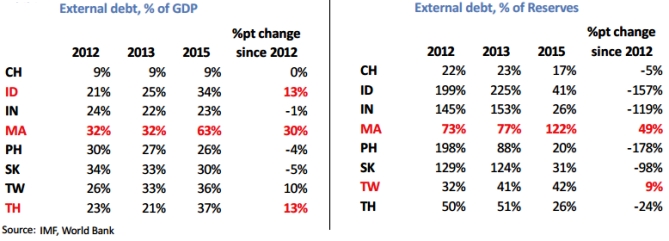Well, the much awaited Fed's stance was finally as dovish as they could be, there are certain concerns about a tail risk scenario developing in Asia. The scenarios are going along with the following channels, when the Fed hikes, US interest rates rise, the USD rises, Asian debt is sold off, Asian corporates are forced into buying USDs to redeem debt, resulting the USD higher, and in turn tightening monetary conditions further, and so on.
MYR the most worrying among Asian currency crosses, bear monitoring metrics such as short-term external debt to GDP and short-term external debt to FX reserves are key indicators of an economy's resilience to external shocks. Malaysia stands out as having the weakest metrics as you can observe from the above diagram briefing evolution of these debt metrics since 2012.
IDR and THB have both seen a noticeable rise in external debt as a percentage of GDP, but the overall ratios remain relatively low at 34% and 37%, respectively. Likewise, Taiwan's reserve cover has deteriorated since 2012, although overall coverage has yet to reach concerning levels. Not only has external debt almost doubled as a proportion of GDP, but reserve cover has also deteriorated sharply.
With a Fed hike around the corner is likely to prolong for another 2-3 months, the spotlight shifts back to the spillover effects on Asian economies. This time, however, we expect a Fed rate hike to have a very different impact on the relative performance of Asian FX. MYR, IDR, TWD, and KRW are the most vulnerable to higher US rates and a higher USD. On the other end of the spectrum, RMB, INR, and PHP appear to be in the strongest positions.
Spillover effects of Fed’s rate decision on Asian FX baskets, MYR under stress

Friday, September 18, 2015 1:21 PM UTC
Editor's Picks
- Market Data
Most Popular
1



 Nigerians throw naira notes around to show love: but it could land you in jail
Nigerians throw naira notes around to show love: but it could land you in jail  Our laser technique can tell apart elephant and mammoth ivory – here’s how it may disrupt the ivory trade
Our laser technique can tell apart elephant and mammoth ivory – here’s how it may disrupt the ivory trade  Ukraine recap: US$60 billion aid package brings fresh hope to desperate Kyiv
Ukraine recap: US$60 billion aid package brings fresh hope to desperate Kyiv  History for sale: what does South Africa’s struggle heritage mean after 30 years of democracy?
History for sale: what does South Africa’s struggle heritage mean after 30 years of democracy?  What’s the difference between ADD and ADHD?
What’s the difference between ADD and ADHD?  Tarantino abandons his tenth film – five other times Hollywood giants cancelled big projects
Tarantino abandons his tenth film – five other times Hollywood giants cancelled big projects  Vaping now more common than smoking among young people – and the risks go beyond lung and brain damage
Vaping now more common than smoking among young people – and the risks go beyond lung and brain damage  New ‘cold war’ grows ever warmer as the prospect of a nuclear arms race hots up
New ‘cold war’ grows ever warmer as the prospect of a nuclear arms race hots up  How breakdancing became the latest Olympic sport
How breakdancing became the latest Olympic sport  Family farms are fast disappearing: our research shows how young generations can take them up successfully
Family farms are fast disappearing: our research shows how young generations can take them up successfully  Half our colleagues suffer pain and discomfort from periods. But they’re still a taboo subject at work
Half our colleagues suffer pain and discomfort from periods. But they’re still a taboo subject at work 





























